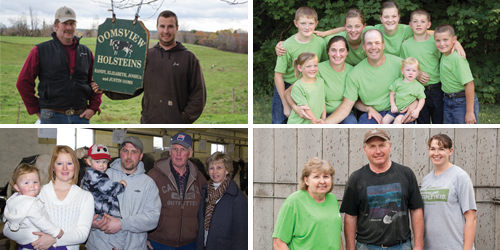
Earlier this week, the February 25 issue of Hoard's Dairyman hit our readers' mailboxes. On pages 118 to 120, four herds from New York to Kansas shared how they manage their tie stall herds. We couldn't fit all they had to share on the three-pages devoted to the Round Table, so two topics were held back for our blog today. For additional information about each dairy, read the Round Table in your most recent issue of the magazine.
Please discuss your cropping and feed storage strategy.
Oomsview Holsteins (New York): In addition to the dairy, we also have a cash crop operation growing corn, soybeans and horse hay. All the forages and energy we need are grown on the farm. Corn silage is stored in Ag-Bags or upright silos. Haylage is stored in Ag-Bags. High-moisture ear corn (snaplage) is stored in upright silos or Ag-Bags. Having almost all of our land tiled makes it possible to plant corn early and harvest haylage early, too.
Roaring Creek Farm (Pennsylvania): We grow all of our own forages. All forages and high-moisture corn are treated during harvesting with inoculants. We use four Harvestores. Two are 20 feet by 80 feet for haylage at 50 percent moisture. One unit is 20 feet by 60 feet for heifer feed. One unit is 20 feet by 45 feet for high-moisture corn. Two trenches are used for corn silage. We line each trench wall with a cover. When we finish filling it, we put down a layer of Silostop, then overlap the two covers, then cover tire to tire over the entire trench.
We have two Ag-Bags for corn silage that measure 12 feet by 200 feet. We have one bag that measures 6 feet by 150 feet for additional high-moisture corn. We try to harvest all crops at optimal feed value and moisture. All feed is tested to determine quality before we use it, and it is tested many more times while we are feeding it to make any changes if needed.
Rokeyroad Holsteins (Kansas): We don't farm a lot of acres. The 120 acres that we rent is right around here. We buy all of our dry hay and pretty much have to buy all of our dry grain and other ingredients. Before we buy anything, we always do tests to check the quality. We don't have any specific parameters set though. We don't like hay that is really rich, but it has to be good enough. The poor stuff we would feed to heifers, if needed, as far as alfalfa. The better hay would go to the milk cows.
The only on-hand feed that we have is our silage. We chop that and put it in bags. We don't purchase any silage. We'll get a spring crop of light triticale, get that chopped off, and then come back in with corn or forage sorghum, and get that chopped off. We're taking a lot off of the land, but then manure helps replenish it.
Wiste Farms (Minnesota): We raise most of the feed. The only purchased feed items are the mineral mix and bean meal for grinding and topdressing. We put silage in a 65-foot silo for the cows and make a pile for the younger livestock and beef cows for the winter. We make big square bales of dry hay for feeding to the cows and high-moisture hay (baleage) in 4.5-foot big squares that we wrap for the cows. We have always been very particular in making sure the dry hay is very dry to ensure its quality.
How do you handle manure?
Oomsview Holsteins: Manure is collected and spread daily on our cropland.
Roaring Creek Farm: We have gutters with grates behind the cows; gutters measure 24 inches. There is a Houle barn cleaner in the barn that we run once a day to deliver manure to a reception pit. We pump to a Slurrystore every four days. All manure is used for our crops.
Rokeyroad Holsteins: We have a gravity flow gutter system, which is 2 feet wide and 2 feet deep. It's flat on the bottom and every 35 feet drops 4 inches, like a stair step. The barn slopes to the center so that the 4-inch drops take up that slope, and then it all drops into a 15-inch pipe that goes out into an earthen lagoon. Once in there, we use it for our cropping program. About twice a year we have to pump out the lagoon with a drag hose and aerator. It works well for fertilizer.
Wiste Farms: Manure is spread on our fields throughout the year for our own cropping program.

The author, Amanda Smith, was an associate editor and an animal science graduate of Cornell University. Smith covers feeding, milk quality and heads up the World Dairy Expo Supplement. She grew up on a Medina, N.Y., dairy, and interned at a 1,700-cow western New York dairy, a large New York calf and heifer farm, and studied in New Zealand for one semester.








